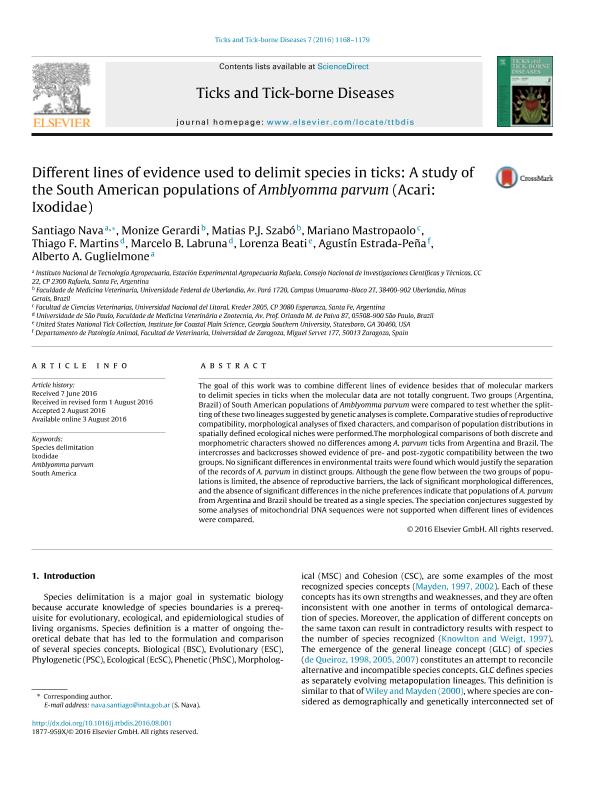Mostrar el registro sencillo del ítem
dc.contributor.author
Nava, Santiago

dc.contributor.author
Gerardi, Monize
dc.contributor.author
Szabó, Matías P. J.
dc.contributor.author
Mastropaolo, Mariano

dc.contributor.author
Martins, Thiago F.
dc.contributor.author
Labruna, Marcelo B.
dc.contributor.author
Beati, Lorenza
dc.contributor.author
Estrada Peña, Agustín
dc.contributor.author
Guglielmone, Alberto Alejandro

dc.date.available
2019-01-30T19:14:45Z
dc.date.issued
2016-10
dc.identifier.citation
Nava, Santiago; Gerardi, Monize; Szabó, Matías P. J.; Mastropaolo, Mariano; Martins, Thiago F.; et al.; Different lines of evidence used to delimit species in ticks: A study of the South American populations of Amblyomma parvum (Acari: Ixodidae); Elsevier Gmbh; Ticks and Tick-borne Diseases; 7; 6; 10-2016; 1168-1179
dc.identifier.issn
1877-959X
dc.identifier.uri
http://hdl.handle.net/11336/69056
dc.description.abstract
The goal of this work was to combine different lines of evidence besides that of molecular markers to delimit species in ticks when the molecular data are not totally congruent. Two groups (Argentina, Brazil) of South American populations of Amblyomma parvum were compared to test whether the splitting of these two lineages suggested by genetic analyses is complete. Comparative studies of reproductive compatibility, morphological analyses of fixed characters, and comparison of population distributions in spatially defined ecological niches were performed.The morphological comparisons of both discrete and morphometric characters showed no differences among A. parvum ticks from Argentina and Brazil. The intercrosses and backcrosses showed evidence of pre- and post-zygotic compatibility between the two groups. No significant differences in environmental traits were found which would justify the separation of the records of A. parvum in distinct groups. Although the gene flow between the two groups of populations is limited, the absence of reproductive barriers, the lack of significant morphological differences, and the absence of significant differences in the niche preferences indicate that populations of A. parvum from Argentina and Brazil should be treated as a single species. The speciation conjectures suggested by some analyses of mitochondrial DNA sequences were not supported when different lines of evidences were compared.
dc.format
application/pdf
dc.language.iso
eng
dc.publisher
Elsevier Gmbh

dc.rights
info:eu-repo/semantics/openAccess
dc.rights.uri
https://creativecommons.org/licenses/by-nc-sa/2.5/ar/
dc.subject
Amblyomma Parvum
dc.subject
Ixodidae
dc.subject
South America
dc.subject
Species Delimitation
dc.subject.classification
Otras Ciencias Veterinarias

dc.subject.classification
Ciencias Veterinarias

dc.subject.classification
CIENCIAS AGRÍCOLAS

dc.title
Different lines of evidence used to delimit species in ticks: A study of the South American populations of Amblyomma parvum (Acari: Ixodidae)
dc.type
info:eu-repo/semantics/article
dc.type
info:ar-repo/semantics/artículo
dc.type
info:eu-repo/semantics/publishedVersion
dc.date.updated
2019-01-22T18:49:39Z
dc.identifier.eissn
1877-9603
dc.journal.volume
7
dc.journal.number
6
dc.journal.pagination
1168-1179
dc.journal.pais
Países Bajos

dc.journal.ciudad
Amsterdam
dc.description.fil
Fil: Nava, Santiago. Instituto Nacional de Tecnología Agropecuaria. Centro Regional Santa Fe. Estación Experimental Agropecuaria Rafaela; Argentina. Consejo Nacional de Investigaciones Científicas y Técnicas. Centro Científico Tecnológico Conicet - Santa Fe; Argentina
dc.description.fil
Fil: Gerardi, Monize. Universidade Federal de Uberlandia; Brasil
dc.description.fil
Fil: Szabó, Matías P. J.. Universidade Federal de Uberlandia; Brasil
dc.description.fil
Fil: Mastropaolo, Mariano. Universidad Nacional del Litoral. Facultad de Ciencias Veterinarias; Argentina. Consejo Nacional de Investigaciones Científicas y Técnicas; Argentina
dc.description.fil
Fil: Martins, Thiago F.. Universidade de Sao Paulo; Brasil
dc.description.fil
Fil: Labruna, Marcelo B.. Universidade de Sao Paulo; Brasil
dc.description.fil
Fil: Beati, Lorenza. Georgia Southern University; Estados Unidos
dc.description.fil
Fil: Estrada Peña, Agustín. Universidad de Zaragoza; España
dc.description.fil
Fil: Guglielmone, Alberto Alejandro. Instituto Nacional de Tecnología Agropecuaria. Centro Regional Santa Fe. Estación Experimental Agropecuaria Rafaela; Argentina. Consejo Nacional de Investigaciones Científicas y Técnicas. Centro Científico Tecnológico Conicet - Santa Fe; Argentina
dc.journal.title
Ticks and Tick-borne Diseases
dc.relation.alternativeid
info:eu-repo/semantics/altIdentifier/doi/https://doi.org/10.1016/j.ttbdis.2016.08.001
dc.relation.alternativeid
info:eu-repo/semantics/altIdentifier/url/https://www.sciencedirect.com/science/article/pii/S1877959X16301248
Archivos asociados
